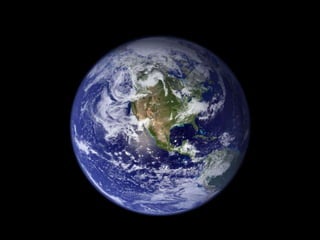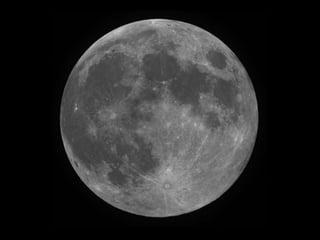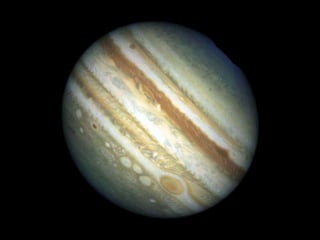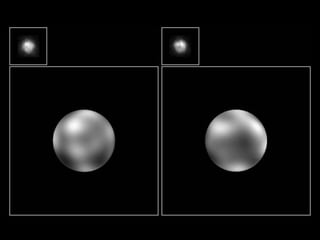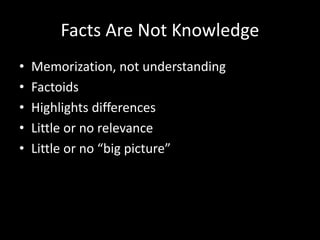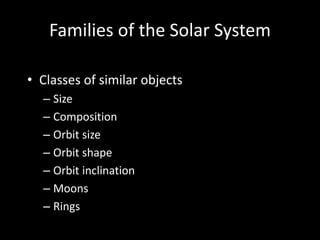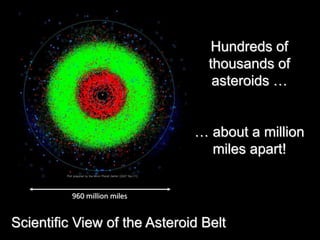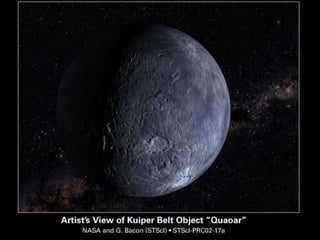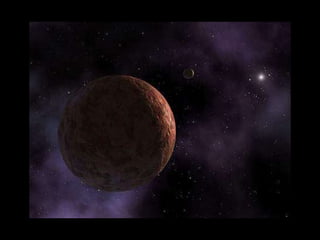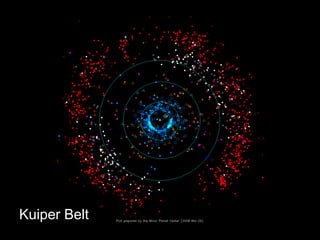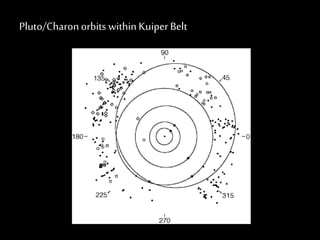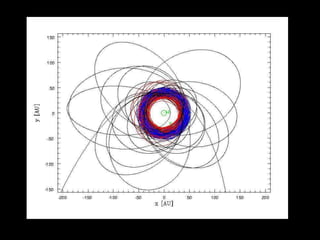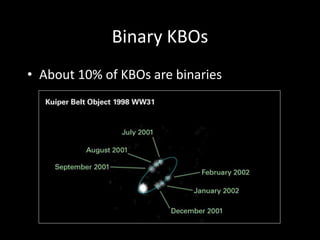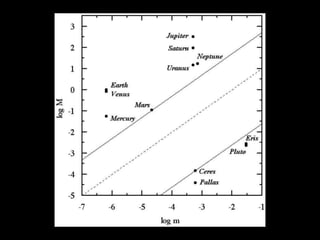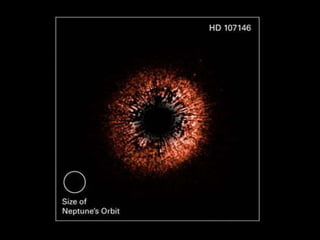Solar system classification
- 13. Your Parents’ Solar System
- 14. Facts Are Not Knowledge • Memorization, not understanding • Factoids • Highlights differences • Little or no relevance • Little or no “big picture”
- 15. Sun Rocky Planets Asteroid Belt Giant Planets Kuiper Belt Oort Cloud The 21st Century Solar System
- 16. Families of the Solar System • Classes of similar objects – Size – Composition – Orbit size – Orbit shape – Orbit inclination – Moons – Rings
- 20. Hollywood’s View of the Asteroid Belt
- 21. Scientific View of the Asteroid Belt 960 million miles Hundreds of thousands of asteroids … … about a million miles apart!
- 22. Sizes of the Giant Planets and Earth
- 23. Kuiper Belt
- 26. Oort Cloud • Billions of icy minor planets – comet nuclei • Roughly spherical out to 50,000 AU • Predicted by Jan Oort • Explains long-period comets
- 27. Figure 1a: Comet Semimajor Axis Distribution 0 100 200 300 400 500 600 -0.004 -0.002 0.000 0.002 0.004 0.009 0.020 0.042 0.088 0.185 0.390 1 / a (1/AU) NumberofComets Short PeriodLong Period Orbital Period: 200 years 7 years
- 28. Sedna
- 29. Sedna • Orbit 76 – 840 AU • Very red color • Outer Kuiper Belt? • Inner Oort Cloud? • Planet at 70 AU?
- 31. Families of the Solar System • Classification • Structure of the solar system – Similar objects lie in similar regions • Clues to solar system formation and evolution
- 32. Rocky Planets Giant Planets
- 34. Sun Oort Cloud Mercury Venus Earth Mars Asteroid Belt Jupiter Saturn Uranus Neptune Kuiper Belt
- 35. Science Out Changes May View Established Models As Basic Justified Standards Until New Knowledge Bears
- 36. Sometimes Over Coals My Very Energetic Mother Also Boils Jumbo Shrimp Using Nine Kettles Bubbling
- 37. The Inevitable Question …
- 38. Why is Pluto No Longer a Planet?
- 39. Planet Pluto January 23, 1930 January 29, 1930
- 40. The Incredible Shrinking Planet • Lowell’s Planet X – 7 times Earth • 1940’s – 1 times Earth • 1980 – 0.1 times Earth • 1985 – 0.002 times Earth
- 42. Double Take: Charon • 1978 – James Christy (USNO) observations to refine Pluto’s orbit • Notices elongated images, deduces moon • 1985 – Charon occults Pluto, confirms existence • Refined sizes and masses – tiny
- 43. Pluto/Charon
- 46. Kuiper Belt • 1930 – Leonard mentions possibility of trans- Plutonian objects • 1943 – Kenneth Edgeworth postulates objects beyond Pluto • 1951 – Gerard Kuiper predicts that a massive Pluto would disperse small objects into a belt • 1980 – Fernandez predicts ‘comet belt’ that resembles what was eventually found
- 47. Kuiper Belt Objects • 1992 – Jewitt & Luu find QB1 • Distance of 42 AU • First (third?) object discovered in the Kuiper Belt
- 49. Kuiper Belt
- 50. More and more KBOs • Large searches for KBOs ensued • Hundreds discovered within a decade • Over 1200 discovered so far • Over 70,000 predicted – diameters > 100 km – orbits 30-50 AU
- 51. Pluto Defenders • Pluto is different from the KBOs • Pluto is bigger than the KBOs • Pluto has a moon, Charon
- 55. Binary KBOs • About 10% of KBOs are binaries
- 56. Eris & Dysnomia (2003 UB313)
- 57. Eris &DysnomiaSanta & Rudolph Easterbunny
- 58. Pluto vs the Kuiper Belt • Orbit similar to KBOs • Size similar to KBOs • KBO companions common • Composition similar to KBOs
- 59. Pluto vs the Kuiper Belt • Orbit similar to KBOs • Size similar to KBOs • KBO companions common • Composition similar to KBOs Pluto has found its family!!
- 60. IAU Definition – August 2006 • IAU defines “planet” 1. Orbits the Sun 2. Upper mass limit • not massive enough to produce fusion • Deuterium fusion occurs at about 15x Jupiter’s mass 3. Lower mass limit • Massive enough for gravity to make it spherical • About 500 miles in diameter 4. Dominates its orbit • Dwarf planets meet 1, 2, 3, but not 4
- 62. Other Planetary Systems? • Solar system alone is category of one
- 68. Beta Pictoris
- 69. We Are Not Alone • Lots of dust disks found • Proplyds – proto-planetary disks • Kuiper Belt sized and larger • Some substructure seen
- 70. Planets around Other Stars • Cannot see directly (yet) • Detect via gravitational pull on star – Wobble – Periodic shift of spectral lines – Monitor for many years (several orbits) – Giant planets detectable
- 71. Planets around Other Stars • Current count (May 2006) – 162 planetary systems – 188 planets – 19 multiple planet systems • At least 15% of sun-like stars have planets



